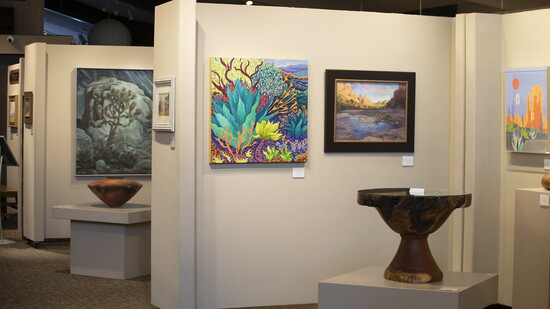There are moments when art does more than fill a gallery—it fills a community with meaning. It stirs something quiet but powerful. A memory. A reckoning. A sense of belonging. This fall, the Fallbrook Art Center opened its doors to such a moment, unveiling the inaugural Southwest Artistry Exhibition, held from September 16 through October 18. For those who explored the exhibition, each canvas and sculpture offered more than visuals — they offered a moment of connection, reflection, and truth. It was spiritual, cultural, a reminder that beauty—when rooted in truth and authenticity—has the power to unite.
The exhibition brought together paintings, photography, sculpture, and mixed media that spoke to the spirit of the American Southwest. But these were not just landscapes or color studies. They were vessels of lived experience. Some whispered of endurance. Others radiated joy. A few offered quiet grief. Each one carried its own voice—its own offering. And together, they wove a portrait of a region that is not easily defined but always deeply felt.
Beyond the gallery walls, the Fallbrook School of the Arts, a division of The Fallbrook Art Center, continues this same spirit by giving people a place to learn, practice, and discover their own creative voices. Whether it’s painting, ceramics, printmaking, or jewelry design, the school offers a space where expression is nurtured and new stories take shape. In many ways, the exhibition inside the Art Center is an extension of that mission—proof of what happens when a community is given both the tools to create and the invitation to share.
The exhibition was curated by artists Helen Shafer Garcia and N. Dixon Fish. Together, they brought more than artistic sensibility—they brought a shared commitment to truth, context, and cultural respect. For them, it was never just about showcasing talent. It was about honoring stories. And honoring the people behind them.
“Southwest exhibitions have continued to expand viewpoints,” Helen shared. “Imagery now embraces broader regions and cultures, adding identity and diversity. This exhibition honors that evolution.”
Dixon, whose connection to the Southwest is rooted in his upbringing on ranches and a long career in the arts, added: “The days of romanticized, often appropriated subjects are behind us. The artists in this show have found both beauty and their voice in this diverse region.”
In their joint curatorial statement, the pair wrote: “We were diligent in selecting pieces that demonstrated cultural appreciation rather than appropriation. This exhibition reflects a range of mediums and influences true to the Southwest.”
These words served not just as a curatorial lens—but as a moral compass. They reminded us that art is not just for display. It is for remembering. For reconciling. For restoring.
In an age when images move fast and meaning is often lost, this exhibition called us to slow down. To notice. To feel. And to listen.
Walking through the gallery, visitors felt not spectacle but reverence. It was an atmosphere of sacred invitation. A call to reflect. To witness. To remember. And perhaps most importantly, to be changed.
As part of our Thankful Issue, this exhibition arrives with deep resonance. Gratitude, when fully lived, becomes collective. It becomes legacy. It becomes a call to preserve what is sacred.
The Fallbrook Art Center has long been a cornerstone of creativity in Southern California. With this exhibition, it becomes something more: a sanctuary for story, memory, and meaning. A space where art is not only admired, but understood. Where beauty is not only seen, but felt. And where purpose, always, leads the way.
“The context of imagery embraces expanded geographical regions and cultures, adding identity, narrative, and diversity.”
“I was looking for the feeling of the real Southwest,” he explained. “As you can see from the work displayed, the days of romanticized subjects—which often led to cultural appropriation—are fortunately behind us. Congratulations to the artists whose work is in this show. You have found both beauty and your voice in a vastly diverse area of the USA.”
